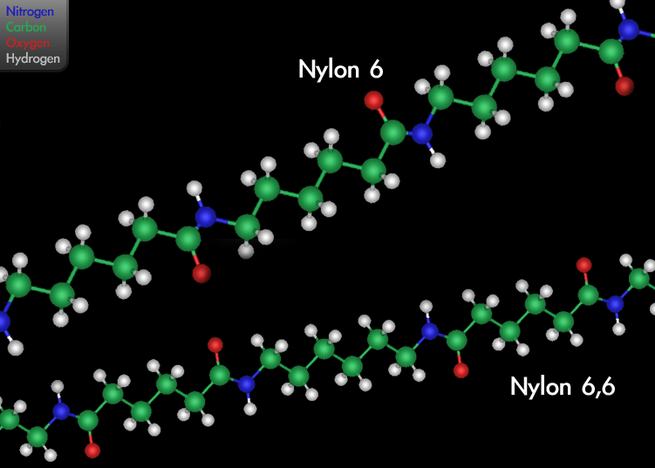Main Difference
The main difference between Nylon and Silk is that the Nylon is a family of synthetic polymers originally developed as textile fibers and fine, lustrous, natural fiber produced by the larvae of various silk moths, especially the species Bombyx mori.
-
Nylon
Nylon is a generic designation for a family of synthetic polymers, based on aliphatic or semi-aromatic polyamides.
Nylon is a thermoplastic silky material
that can be melt-processed into fibers, films or shapes.Nylon was the first commercially successful synthetic thermoplastic polymer. DuPont began its research project in 1930.
The first example of nylon (nylon 6,6) was produced using diamines on February 28, 1935, by Wallace Hume Carothers at DuPont’s research facility at the DuPont Experimental Station. In response to Carothers’ work, Paul Schlack at IG Farben developed nylon 6, a different molecule based on caprolactam, on January 29, 1938.Nylon was first used commercially in a nylon-bristled toothbrush in 1938, followed more famously in women’s stockings or “nylons” which were shown at the 1939 New York World’s Fair and first sold commercially in 1940. During World War II, almost all nylon production was diverted to the military for use in parachutes and parachute cord. Wartime uses of nylon and other plastics greatly increased the market for the new materials.Nylon is made of repeating units linked by amide links similar to the peptide bonds in proteins.
Commercially, nylon polymer is made by reacting monomers which are either lactams, acid/amines or stoichiometric mixtures of diamines (-NH2) and diacids (-COOH). Mixtures of these can be polymerized together to make copolymers. Nylon polymers can be mixed with a wide variety of additives to achieve many different property variations.
Nylon polymers have found significant commercial applications in fabric and fibers (apparel, flooring and rubber reinforcement), in shapes (molded parts for cars, electrical equipment, etc.), and in films (mostly for food packaging).
-
Silk
Silk is a natural protein fiber, some forms of which can be woven into textiles. The protein fiber of silk is composed mainly of fibroin and is produced by certain insect larvae to form cocoons. The best-known silk is obtained from the cocoons of the larvae of the mulberry silkworm Bombyx mori reared in captivity (sericulture). The shimmering appearance of silk is due to the triangular prism-like structure of the silk fibre, which allows silk cloth to refract incoming light at different angles, thus producing different colors.
Silk is produced by several insects, like silk worms but generally only the silk of moth caterpillars has been used for textile manufacturing. There has been some research into other types of silk, which differ at the molecular level. Silk is mainly produced by the larvae of insects undergoing complete metamorphosis, but some insects such as webspinners and raspy crickets produce silk throughout their lives. Silk production also occurs in Hymenoptera (bees, wasps, and ants), silverfish, mayflies, thrips, leafhoppers, beetles, lacewings, fleas, flies, and midges. Other types of arthropod produce silk, most notably various arachnids such as spiders.
-
Nylon (noun)
Originally, the DuPont company trade name for polyamide, a copolymer whose molecules consist of alternating diamine and dicarboxylic acid monomers bonded together; now generically used for this type of polymer.
-
Nylon (noun)
A stocking originally fabricated from nylon; also used generically for any long, sheer stocking worn on a woman’s legs.
“They left the strip club when they discovered the ladies only stripped down to their nylons.”
-
Silk (noun)
A fine fiber excreted by the silkworm or other arthropod (such as a spider).
“The silk thread was barely visible.”
-
Silk (noun)
A fine, soft cloth woven from silk fibers.
-
Silk (noun)
Anything which resembles silk, such as the filiform styles of the female flower of maize.
-
Silk (noun)
The gown worn by a Senior (i.e. Queen’s/King’s) Counsel.
-
Silk (noun)
A Senior (i.e. Queen’s/King’s) Counsel.
-
Silk (noun)
A pair of long silk sheets suspended in the air on which a performer performs tricks.
-
Silk (noun)
The garments worn by a jockey displaying the colors of the horse’s owner.
-
Silk (verb)
To remove the silk from (corn).

